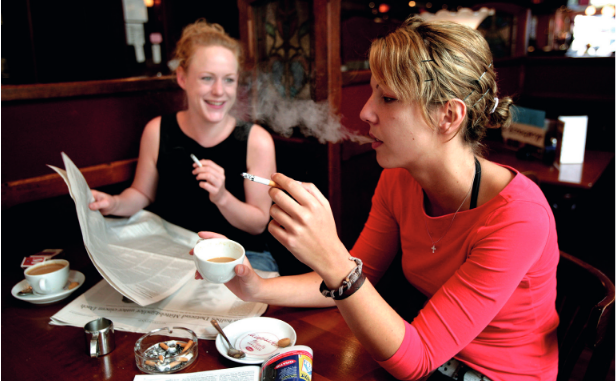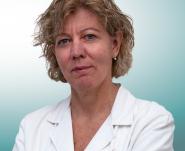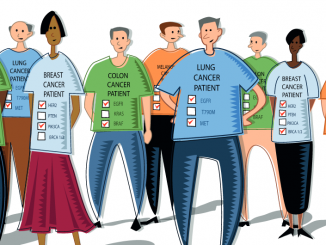
Building a lung cancer team that works seamlessly to do the best for each patient was the biggest challenge in Enriqueta Felips career. Her focus today is on increasing collaboration across Europe, which she sees as key if patients are to benefit quickly from the new opportunities offered by personalised therapies.
 It’s a clear and crisp morning, but the air outside Vall d’Hebron Hospital overlooking Barcelona is far from fresh. There’s the pervasive smell of tobacco smoke outside the red-marbled hospital reception as patients stand around getting their nicotine fix. Around the corner, in less conspicuous places, there are people in white coats doing the same thing.
It’s a clear and crisp morning, but the air outside Vall d’Hebron Hospital overlooking Barcelona is far from fresh. There’s the pervasive smell of tobacco smoke outside the red-marbled hospital reception as patients stand around getting their nicotine fix. Around the corner, in less conspicuous places, there are people in white coats doing the same thing.
It’s a sight that deeply disturbs Enriqueta Felip, head of the hospital’s lung cancer unit. Felip, who has established her unit as one of Europe’s most important centres for researching innovative lung cancer therapies, is not a woman given to making statements based on anything but the clearest evidence. And when it comes to smoking, she is unequivocal.
“Around 85% of lung cancer would not exist if it were not for smoking,” says Felip, who is Associate Professor of Medicine at Barcelona’s Universidad Autónoma. “So yes, it deeply worries me when I see people smoking, especially outside the hospital. As professionals, we have to give out messages to stop tobacco use every day… but it is not easy. It is an addiction.”
Those working in lung cancer must, perhaps, have special qualities. Their conviction that things could – should – be different is countered by a deep pragmatism about making the best of things as they are, and a non-judgemental compassion for their patients. Felip, who is in charge of both management of lung cancer and trials at the hospital, is full of both qualities: there’s a job to be done to help people. “I always tell my patients it’s not their fault. Give up smoking now, yes, but don’t feel guilty.”
The last thing her patients need is a guilt-trip. Although advances in the management of non-small-cell lung cancer, which makes up more than eight out of every ten lung cancers, have led to small increases in five-year survival rates across Europe over the past 30 years, the prognosis for most people diagnosed with lung cancer is still poor. Averaged across Europe, only 13% of people survive for five years after diagnosis, according to the EUROCARE-5 study published this year. In most cases the disease is already advanced by the time it is diagnosed. Fully 50% of Felip’s patients are diagnosed with stage 4 disease, 30% at stage 3 and only 20% at stages 1 and 2 – so palliative therapy has long been the mainstay of treatment.
But things are beginning to change. Specialist care in Barcelona has taken a major upturn since Felip established the thoracic unit from scratch 20 years ago – a time when there was still debate over whether patients with stage 4 disease should be treated at all.
And thanks to increasing understanding of the molecular biology of the disease, the landscape of lung cancer treatments is changing radically, giving future patients – and those currently included in clinical trials – the prospect of new life-extending options. One of the main reasons that Enriqueta Felip has remained at Vall d’Hebron is that phase I facilities are available that have allowed her to work on the development of the next generation of drugs for lung cancer.
New approaches are desperately needed to improve not only patients’ prospects but also the perception of lung cancer within oncology as a specialism where the success rate is pitifully poor and progress depressingly slow. Lung cancer is the commonest form of cancer globally (13% of all cases, according to the International Agency for Research on Cancer), and the main cause of death from cancer (accounting for 1.59 million deaths a year). Even though lung cancer causes more cancer deaths than prostate, breast and colon cancer put together, it struggles in most countries for the attention of politicians, funders and the public, compared to gender-specific cancers. As Felip points out, the economic crisis in countries such as Spain has recently made the fight for funding for translational research even more difficult. “We currently have support, but we need to be sure that this will be maintained, or increased, in the future.”
The struggle for profile isn’t helped by persisting attitudes that those with lung cancer have only brought the disease on themselves – conveniently overlooking the role of industry in turning them into addicts in the first place.
The alarming fact is that lung cancer is on the rise among women. In the early 1900s, Felip points out, lung cancer was virtually unheard of in women. “But since the 1960s it has progressively reached epidemic proportions, becoming the leading cause of cancer deaths among women in the United States, and the third most common cause of cancer death in women in Europe.”
The increase may well be solely because women are smoking more, or it may also be because they are more susceptible to the carcinogens in tobacco smoke – several case control studies have indicated this, though the association is still far from established.
“Women tend to be much more aware of other cancers, such as breast cancer,” she says. “They are having mammographies for breast cancer and that is good, but they are still smoking, even though lung cancer is the main reason for cancer-related death in some countries. Around a quarter of the patients I see in my office are women, and this was not the case ten years ago. In 2007, we started a national collaboration to capture the clinical characteristics of women with lung cancer, and we thought it would take eight to nine years to collect enough women, but we did it within five.”
“They are having mammographies for breast cancer and that is good, but they are still smoking”
Felip has noted another alarming trend: people with lung cancer are getting younger. The average age people receive a lung cancer diagnosis is 65, but Felip is today treating her youngest patient ever, a 25 year old. “I don’t have clear data on this, but it is certainly true that nowadays I see younger patients with stage 4 disease – 33, 35, 37 years old is not unusual.” “Nowadays I see younger patients with stage 4 disease – 33, 35, 37 years old is not unusual”
Despite this, and despite her perplexity that smoking is still blithely pursued by so many, Felip refuses to be gloomy.
“I think the scenario is changing,” she says. “We have some patients who are living a long time, and clinical trials with very impressive results.”
The big game changer in the past decade was the discovery, in 2004, that up to 20% of non-small-cell lung cancers cases harbour mutations in the epidermal growth factor receptor (EGFR) proto-oncogene. Studies have indicated that treating this subgroup of patients with oral tyrosine kinase inhibitors (TKIs) that inhibit EGFR extends their progression-free survival and improves their quality of life – and is more effective than chemotherapy as a first-line treatment. Testing for the mutation makes it possible to identify which patients will particularly benefit from this treatment.
“This has significantly changed treatment,” says Felip. But things have moved on further. Research by Felip has revealed the molecular mechanisms by which many people acquire resistance to this treatment, after an initially dramatic response. The presence of an EGFR mutation, designated T790M, is linked with resistance, and Felip is now involved in ongoing clinical trials evaluating T790M-specific inhibitors. “We are seeing very good responses to this.”
The other big story in lung cancer was the discovery in 2007 that around 5% of patients with non-small-cell lung cancer – often never smokers – have a gene inversion on chromosome 2 which results in an oncogene called EML4-ALK or the ALK translocation oncogene. Recent preclinical and first-in-human studies have demonstrated that an oral ALK-inhibiting TKI achieves a response in almost six out of ten patients. A randomised trial in patients with advanced ALK-positive tumours has shown that treatment with an ALK inhibitor significantly extends progression-free survival and improves quality of life when compared to chemotherapy. New ALK inhibitors are now in the pipeline, and new molecular markers are continually being identified, providing potential for more targeted therapies. “It’s a very exciting area,” says Felip.
That is the present. The future will present more treatment options. Immunotherapy is about to change treatment algorithms for patients with non-small-cell lung cancer, says Felip. Until now, the big idea of using the body’s own immune system to attack cancer cells has yielded little of practical value for people with lung cancer. But advances in the understanding of the immune response to tumours – particularly the programmed death (PD) pathways – have led to the development of several new antibody-based treatments.
Recent phase I trials in lung cancer have shown a response in more than two in ten patients who had already undergone previous treatment. What is especially exciting is that the patients who benefit most from immunotherapy are those for whom ALK- or EGFR-inhibiting drugs are unlikely to bring benefits. “Importantly, these drugs are well tolerated and we have seen long-lasting responses,” says Felip.
With treatment horizons moving towards individualised molecular approaches, the availability of biomarker testing is now becoming an important priority for people with lung cancer.
“Lung cancer is becoming a paradigm for personalised therapy, and we need to ensure that all lung cancer patients in Europe are tested for EGFR and ALK alterations, and treated accordingly. There are also other biomarkers that we are beginning to understand are important, such as BRAF, HER2, and ROS1.”
It’s with a view to making the most of these developments in a coordinated way across Europe that Felip has this year accepted the role of programme co-ordinator for lung cancer with the European School of Oncology. She organised the first ever ESO ‘Lung Cancer Observatory’ at the European Lung Cancer Conference in Geneva this March. Drawing together medical oncologists, surgeons, pathologists, biologists, other health professionals and patients, it effectively set an agenda for the ESO lung cancer programme for the next 12 months.
“Working closely with pathologists and biologists has become so important in lung cancer”
“We need to push forward with a European programme for lung cancer, so I’m very excited that in forums like this we have the opportunity to share, discuss and work together on the priorities at a European level.”
European collaboration is, Felip believes, one of the biggest challenges facing lung cancer. It is already happening to some extent through ESO and the European Thoracic Oncology Platform, but if surgeons, oncologists, pathologists and all those specialising in lung cancer could do more to break their national boundaries, collaborate on trials and share information, important questions would be answered more quickly.
For Felip, there are clear priorities for action. One is finding ways to involve increasing numbers of patients in clinical trials of “these exciting new molecules” in early-phase development. Another is to find ways of integrating the molecular profiling of patients into clinical practice throughout Europe. “In the next decade, lung cancer treatment should change to be the paradigm of personalised therapy; to my mind it is now essential to know whether the patient has EGFR or ALK mutations.”
Implementing screening programmes to increase detection of non-small-cell lung cancer at a much earlier stage, when it can still potentially be cured by surgery, is also a priority, Felip believes. Although ESMO advised, in 2010, that trials of low-dose CT scanning of high-risk people had not yet produced enough evidence of overall benefit, the ESMO Guidelines Working Group is currently looking at newer data with a view to updating the guidelines.
“To me it is clear,” says Felip, who serves on the Guidelines Working Group editorial board. “The study from the National Cancer Institute in America showed a 20% reduction in lung cancer deaths among current or former heavy smokers who were screened with low-dose CT scans. It’s true that there are a number of aspects that should be resolved before this becomes a standard of care. We need to know it is cost efficient, we need specialised centres, and we need skilled radiologists, because interpreting these images is not easy. But there is currently a lack of awareness of the issue among clinical oncologists, and no clear guidance on screening strategies. So for me this is a clear area to discuss at the European level.”
Felip, a subject editor of minimum clinical recommendations for diagnosis, treatment and follow-up in lung cancer for ESMO, is today one of Europe’s most respected names in lung cancer. She has achieved her reputation by quiet diligence, not by blowing her own trumpet.
She was born in Barcelona, and has always lived there. She says she went into medicine simply because she liked people and liked science – and the subject combined both. After completing her medical degree at the Universidad Autónoma in 1987, she decided to take a residency in medical oncology at the associated Vall d’Hebron Hospital: “I knew surgery wasn’t for me; with oncology there was the opportunity not just for research, but to have a relationship with people living with disease. This is important: it’s our objective, it’s the most important thing.” And she was immediately drawn into lung cancer. During her residency, she spent three months working at the thoracic unit of the Memorial Sloan Kettering Cancer Center in New York, and on her return and completion of her PhD her then boss, José Baselga (now at Memorial himself), encouraged her to set up a thoracic unit with specialised staff.
“Oncology offered the opportunity not just for research, but to have a relationship with people living with disease”
“Up until then, nobody was doing lung cancer in my institution,” she says. “There were people treating breast cancer and colon cancer, but not lung cancer. So when I finished my residency in 1992 there was this opportunity to build something.
“For years I was the only medical oncologist in my hospital seeing people with lung cancer. But today I have a department with four specialist medical oncologists seeing more than 400–500 new patients a year. The situation has changed hugely, and I have had great support from my bosses, but it has not been easy. You have to fight for excellence in lung cancer, and I think specialised professionals are essential if you want to achieve the best results.”
There have been opportunities for Felip to move on, but what has kept her in Barcelona has been the prospect of building the thoracic unit even further, the opportunities available for trial collaborations, and the good facilities for early-phase clinical trials: “I have the opportunity here to work on immunotherapy, T790M inhibitors and ALK second-generation inhibitors, because we have the facilities.”
For the past ten years, tumour boards and multidisciplinary collaboration have been fundamental to the Vall d’Hebron approach – and Felip continually emphasises their fundamental importance in lung cancer. This is growing as treatments become more advanced, and there is the need for input from the patient and palliative care teams from the earliest stages.
“The biggest challenge I have had in my career has been building a good team. It is important for so many reasons. It means we can give the best possible attention to the patient. It means we have support and can share with colleagues in sad situations.
“Today, we have tumour committee meetings twice a week. We discuss a tailored approach for each patient, how to get a good picture of the extent of disease. We know that for a group of patients, combined chemotherapy and radio-therapy achieves good results. We have also learned how to select patients for individualised therapy, so we discuss the best ways to get tissue samples for molecular marker testing. Working closely with pathologists and biologists has become so important in lung cancer – tumour sampling is vital, and the number of markers you are looking for is growing all the time. It means we are working with thoracic surgeons in a different way. Even with stage 4 disease, where surgery wouldn’t otherwise be indicated, we sometimes need their involvement to provide samples.”
I raise the subject of women in oncology. Felip is, after all, a high-flyer in a male-dominated world. She was also a panellist at the ESMO Women for Oncology (W4O) Forum at the 2013 European Cancer Congress. W4O aims to help female oncologists access leadership positions, in the light of a recent ESMO survey which indicated that less than 15% of women oncologists have a leadership position.
So does she think that women face problems in reaching the top in oncology? Her answer is guarded. Both men and women face the challenge of having enough time, especially time for a family, says Felip. She agrees that some women definitely have problems with childcare and taking a break in their career, but argues that it is families that need support, not necessarily women.
“We have a lot of women oncologists in Spain and in Europe, and many in very senior positions, and I don’t think we are under-represented,” she says. “I think W4O is a good initiative, because it is good that women physicians can share the range of their experience with men, and that is important if we are working together. But personally, I don’t see any problems with being a woman in oncology.”
She is reluctant to be drawn on the subject because (being a stickler for evidence) “I don’t have a clear picture of the situation,” and acknowledges that her view is dictated by her own experience. She has a seven-year-old son, and has been lucky to have the constant help of her retired parents, who looked after him when he was a baby, and get him to school and back today.
“Our lives are very busy. I do a lot of travelling to conferences because I believe it’s very important to interact with people and share information – it’s part of my job. It’s not a problem – I can do it. And it shouldn’t be a problem for men either.”
“I believe it’s very important to interact with people and share information – it’s part of my job”
So what advice would she offer to a young woman wanting a career in oncology? “I think they should work hard, apply for grants, talk to oncologists in key positions, go to congresses, be involved. They should compromise.” I’m intrigued she feels that compromise should be important to the work of oncologists, and then become puzzled when she uses the word again, as I ask her about the greatest influence on her career.
“Compromise,” she says. “Getting involved. Improving our patients’ profile. Learning every day.” I ask her to explain what she means by compromise, and then we work out that we are experiencing one those linguistic misunderstandings that can cause complications at international level. The Spanish word “compromiso” means commitment in English.
Far from saying that it is important to adjust your own views according to those of others, she is asserting the opposite – the need to pledge oneself to a cause. And if there is a cause that needs the commitment of people like Felip – bringing profile, knowledge and hope – it is lung cancer.





